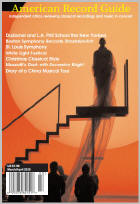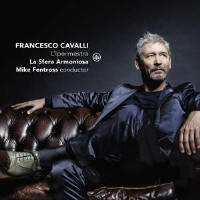Texte paru dans: / Appeared in: Challenge Classics |
|
|
Outil de traduction ~ (Très approximatif) |
|
|
Reviewer: Ralph
Locke Here is a belated but urgently needed release: the world-premiere recording of Francesco Cavalli’s opera L’Ipermestra (1658), sometimes spelled Hipermestra). The recording is of a single performance in 2006 by La Sfera Armoniosa, an early-music group based in the Netherlands, founded in 1992 by the prominent Dutch lutenist Mike Fentross. According to the booklet essay (lumpily translated), Cavalli began writing this opera for the birthday of Vittoria della Rovere, grand duchess of Florence, in 1654—an event that would coincide with Carnival celebration and with the opening of a new theater. But the theater project got delayed, and Cavalli’s opera may thus have simply been set aside until another suitable occasion appeared. It was finished several years later to celebrate (in Florence) the birth of a son and heir to King Philip IV of Spain.
The opera has a somewhat mechanical libretto by the court poet (and court physician) Giovanni Andrea Moniglia. It takes as its background the ancient tale of the Danaids. Danaus (in the opera, Danao), king of the Greek city of Argos, has been told that he will be murdered by one of his brother’s 50 sons. (His brother is king of Egypt.) Danaus therefore instructs his 50 daughters to wed those cousins and then to murder them on the first night. His daughter Hypermnestra (Ipermestra) loves Linceus (Linceo) and does not kill him, which then sets more grisly matters in motion.
These dramatic events would become the basis for an important opera by Salieri in 1784, Les Danaides, which has been recorded several times (most recently by a first-rate cast under Christophe Rousset : Jan/Feb 2016). Also, a famous libretto by Metastasio on roughly the same subject, Ipermestra, was set at least 28 times between 1744 and 1843. In the Cavalli, composed decades earlier than any of the others, the larger tale is treated primarily as framework. There is a tangle of love relation-ships, similar to what would soon become normative in the tragedies of Racine (e.g., Andromaque). There are two couples: Ipermestra and Linceo; and her lady-in-waiting Elisa and the warrior Argante. Ipermestra, as the myth requires, loves Linceo, putting her at odds with her father’s command to kill the young man. Linceo thinks he loves Elisa. Elisa loves Argante but fears that Ipermestra does, too. And Argante indeed falls for Ipermestra (to her dismay). Both men have to wise up for the opera to end, and they do. Along the way, Linceo, having been misinformed that Ipermestra has married somebody else, wages war on Argos, and King Danao dies in the fray (fulfilling the prediction). There is also a nurse (sung by a high tenor), the one comic role in an opera that is otherwise more consistently serious than many of Cavalli’s. The music consists mostly of longish exchanges in a highly expressive recitative style (with continuo accompaniment) that some-times crystalizes into a short aria or tuneful refrain—or even an occasional duet, with more instruments than just the continuo group. (Cavalli composed before the Baroque convention of the longer aria, with many word repetitions and in ABA form.) Some of these scenes incorporating aria-like passages are quite touching or intense and could become items on recitals and anthologies.. I recommend Ipermestra’s ‘Piangete, Occhi, Piangete’ (five wonderful lamenting minutes long—disc 1, track 9), Danao’s ‘Affetti, Pieta, Partite di me’ (disc 2, track 8: another pained lament, followed by an arioso of determination to do what a king and military leader must do). Arbante’s ‘Disperato Cor Mio’ (disc 3, track 5) traverses a world of moods in a mere three minutes, and the happiness duet for Ipermestra and Linceo (disc 3, toward the end of track 17), has the “second couple” (Elisa and Arbante) joining in. I was startled to hear a mini-lament for Elisa (disc 3, track 7, beginning at 3:26: ‘Afferma il Sole’) that anticipates the famous final aria of Puccini’s Mimi (‘Sono Andati?’), with its vocal line that descends stepwise across a full octave.
There are also long passages where the characters interact in expressive recitative that does not ever “tighten” into aria-like metric regularity. The opera here lasts 2-1/2 hours, and this recording skips Act 1, scene 10, and Act 2, scenes 13-20. Fortunately, the cast members, though light-voiced and none very famous, sing with largely steady and beautiful tone, and understand what they are singing about, varying the tempo to reflect the libretto’s many shifts in emotional tone. Sopranos Elena Monti and Gaëlle Le Roi—the former warm-voiced, the latter bright-voiced—convey appropriate measures of yearning and suffering as Ipermestra and Elisa. Monti shows a particularly admirable control of vibrato, even bleaching the tone of it for expressive effect, as at several points in the six-minute long scene (with several mini-arias) in disc 3 track 10. To the pants role of Linceo (originally for castrato), mezzo Emanuela Galli brings both sweetness and cutting declamation of the text, putting across the character’s sincerity, energy, and hotheaded-ness. Marcel Beekman makes the nurse comical but, fortunately, does not overplay. I’m glad he toned down the “funny voice” somewhat for his little arias. Mark Tucker is, by turns, appropriately heroic and lovelorn as Arbante; though when he gets loud and excited, the vibrato widens and pitch becomes unclear. Sergio Foresti is grim and authoritative as King Danao, his range comfortably extending to the role’s many crucial low notes (his vibrato, too, is a bit wide).
Fentross’s continuo group is lively and varied: six players, using two harpsichords, virginal, organ, two harps, and several lutes and guitars. Other instruments appear in some musical numbers: 9 strings, 2 trumpets, a sackbut (often reinforcing Danao’s regal authority) and percussion (evoking the climactic battle quite startlingly at the end of Act 2). Tempos always feel “just right”, and Fentross and the singers and conductor vary them pleasingly, sometimes halving the pace (or even more) for expressive effect. The two main orchestral passages that the opera requires are lacking in the surviving manuscript. Thus the performers borrow an overture from Cavalli’s Doriclea (1645). The battle music comes from a collection of pieces for strings and continuo by Andrea Falconieri (1650). Music does not survive for the opera’s prologue. I assume its text can be found in 17th Century publications of Moniglia’s libretti. I wish it had been included in the booklet; presumably it could help us sense how the plot was understood in the Florentine court. The booklet is somewhat bare-bones, giving the libretto in Italian only. The track list contains characters’ names but not the first words sung in the track. Also, the characters’ names are not always given in the order we hear them. But we do get vivid photos suggesting that the performance (staged, with simple, era-appropriate sets and costumes) was as effective to the eye as to the ear.
An online version of the
booklet has a Dutch translation of the libretto and lengthy
bios in
English reporting on the singers’ activities since 2006. Lovers of Baroque
opera will welcome this release: the first recording—and a very accomplished
and communicative one—of an important opera by a pioneer and master. | |
|
|
|
|
Cliquez l'un ou l'autre
bouton pour découvrir bien d'autres critiques de CD |
|




